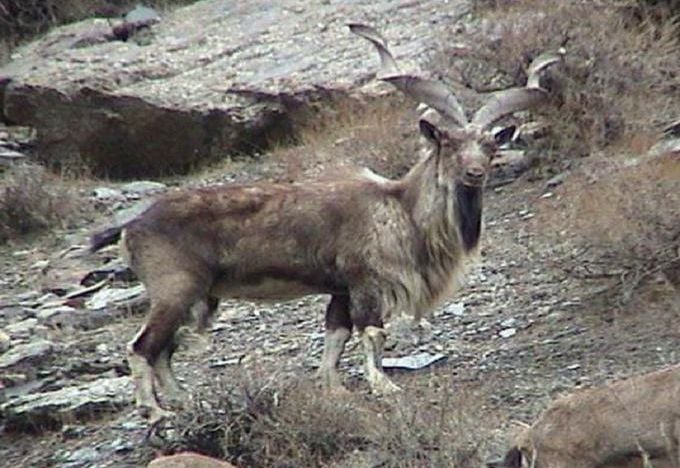by Wisal Yousafzai/ Feb 7, 2024


In Feb 2024, a Russian national hunted a 10-year-old Kashmir Markhor in Kaset village of Toshi Shasha conservancy of Lower Chitral district, paying a trophy hunting permit fee of Rs 51 million to the wildlife department.
An office-holder of the village conservation committee (VCC) said that that this was the first-ever trophy hunting in the village. He said they had long been waiting for it. He said that the community members extended help to Denis Morozov to search an animal of the trophy size. He added they took two days to find the animal as the hunter wanted an animal of maximum horn size. “We were fortunate to spot a markhor with 49-inch horn size.” He said that the Russian easily hunted down the markhor by firing at it from a medium range standing atop a cliff. He said last month an American hunter had hunted a markhor of 45-inch horn in Toshi Shasha conservancy.
Eighty per cent of the income accrued from the permit fee of the trophy hunting of markhor goes to the local community through the village VCCs, which have been organized in different villages by the wildlife department.
However, residents of Chitral feel that they never get to see any of the money the government earns from allowing Markhor hunts.
Although trophy hunting is legal in the country to aid conservation efforts and more importantly for those who can make the highest bid, the money from these bids often never trickles down to the communities where the hunt takes place, which has left them disgruntled.
For instance, as per the Khyber Pakhtunkhwa Wildlife Department, towards the end of the preceding year, in December to be precise, an American citizen paid an astonishing 212,000 dollars to hunt a nine and a half year old Kashmir Markhor in Chitral. According to officials familiar with the matter, the American national’s bid was the highest they had received, therefore, he was allowed to hunt at the Toshi Shasha Markhor conservancy of Lower Chitral.
However, the populace which lives nearby the conservancy area is upset that their community will never get to see any of the money made through the bidding process. Salimuddin, a long-term resident of the area, while talking to the Express Tribune, about the supposedly flawed bidding process which does not divert money to locals, said that the employees of the Chitral National Park are still deprived of endowment money and there are many villages where basic facilities are still not available. “Nevertheless, the government does not seem to care,” regretted Salimuddin.
“On paper the government says that 80 per cent of income from the bidding process for Markhor hunting will be spent on welfare of the locals and 20 per cent will go to the government treasury. This is not the ground reality,” he elaborated.
“If the government were to distribute bidding money as it claimed then Chitral would not lack basic facilities, education, health, and employment,” the local resident remarked.
The people of Chitral said that the government makes millions of rupees every year from trophy hunting and never spends a single penny on the people of the area. Be that as it may, Hussain also has a problem with the government’s selectiveness in picking areas for trophy hunting. “There are about 11 villages near the Chitral National Park where Markhor hunting is not allowed. In these villages, valuable Markhor, Chakor, and birds can be found, but the government’s monopoly on where trophy hunting can take place results in these animals being wasted,” he explained.
“If the government were to allow hunting in these villages, not only would it aid conservation efforts, it would also change the destiny of the local populace, as they would be able to make money off the hunters that visit,” they say.
In light of Salimuddin’s grievances and Hussain’s suggestion, the Express Tribune spoke with Farooq Nabi, the Divisional Forest Officer of the Wildlife Division in Chitral. “It is a fact that 80 per cent of the money made from trophy hunting goes towards various development works taking place in the area. In this regard, various committees have been set up, which are given money for the completion of projects,” informed Nabi, further adding that trophy hunting had already changed the destinies of the local populace.
With regards to the lack of permission to hunt in certain areas, Nabi said that this was out of his hands. “The villages close to the Chitral National Park fall in the national heritage area and thus hunting permits in these villages can only be obtained from the United Nations (UN). The government has already submitted a request to the UN for hunting to be allowed here and is currently waiting for permission,” said Nabi.
